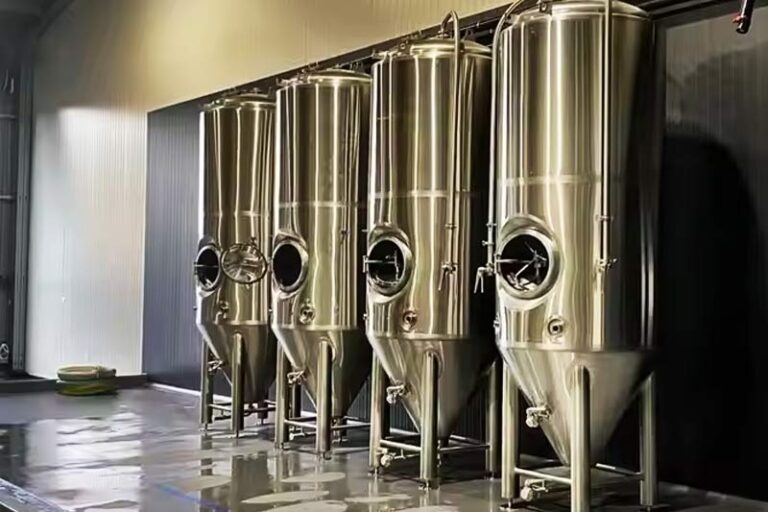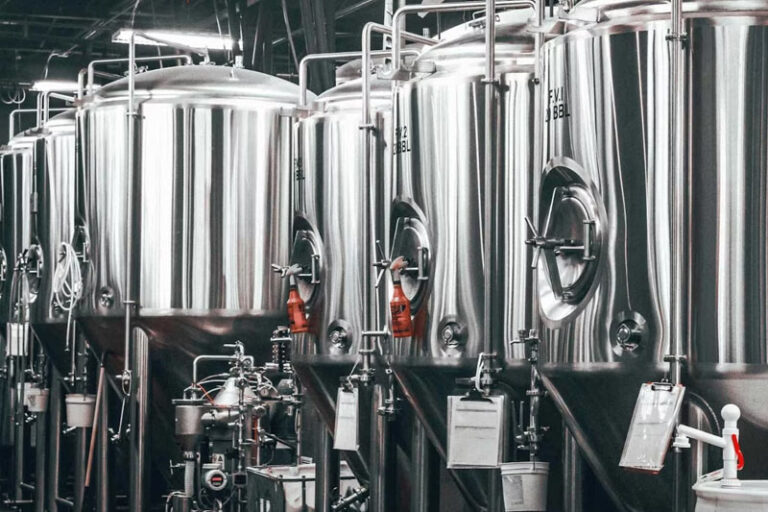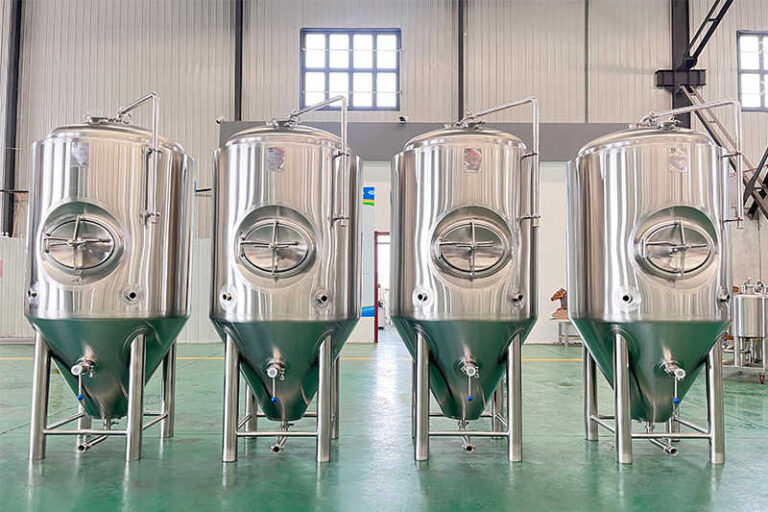In the beer production and brewing process, the fermentation step is undoubtedly the most critical, and the core equipment supporting this key link is the fermentation tank. The fermentation tank is not only the core component of the beer brewing process, but also a key factor affecting the flavor, quality, safety, and production efficiency of beer. This article will give a detailed introduction to the fermentation tank in beer brewing, and deeply explore its role, structure, classification, management, and its importance in the entire brewing system.
The basic function of the fermentation tank
Provide an environment for microbial growth and fermentation
The basic function of the fermentation tank is to provide an environment suitable for the growth, reproduction, and fermentation metabolism of microorganisms such as yeast. In beer brewing, fermentable sugars such as maltose are released through the initial mashing and boiling processes. In the fermentation tank, yeast converts these sugars into alcohol, carbon dioxide, and various flavor compounds.
Controlling temperature and pressure
The fermentation process is an exothermic reaction, and temperature changes will directly affect the activity of yeast and the composition of metabolites. Modern fermenters are equipped with cooling jackets and temperature control systems to accurately control the fermentation temperature and thus obtain stable product quality. In addition, some types of fermentation require pressurized conditions, and the fermenter can also maintain a certain internal pressure to promote the generation and retention of carbonic acid.
Avoid contamination and oxidation
The high-quality beer fermentation process requires an extremely strict aseptic operating environment. As a closed system, the fermentation tank can effectively prevent the invasion of bacteria in the air and avoid the generation of odors. In addition, the fermentation tank can also prevent oxygen from entering the fermentation liquid, preventing the beer from oxidation and deterioration, thereby extending the shelf life of the beer.

Structure and composition of the fermentation tank
Main structure
Fermentation tanks are usually made of stainless steel, which has good corrosion resistance and is easy to clean. According to process requirements, its structure can be divided into open type and sealed type, among which the sealed type is the mainstream choice for industrial production. The tank body is generally cylindrical with a conical bottom to facilitate yeast sedimentation and collection.
Cooling system
The cooling system of the fermentation tank usually uses an outer wall cooling jacket or a built-in coil circulating water cooling to ensure that the fermentation temperature is stable within the required range. Some high-end equipment is equipped with zoned temperature control, which can achieve temperature difference control between different parts of the upper and lower parts to more accurately regulate yeast metabolic activities.
Sampling port and drain port
To facilitate monitoring of the fermentation status, the fermentation tank is equipped with multiple sampling ports, which can be used to regularly extract the fermentation liquid for testing of parameters such as sugar content, pH, and alcohol content. The bottom drain port is used to discharge dead yeast and residues for easy cleaning and preparation of the next batch.
CIP system
The CIP system is an essential part of the fermentation tank. It can achieve online cleaning and disinfection without disassembly. It usually includes alkaline cleaning, hot water washing, acid cleaning, and disinfection to ensure that the equipment meets the hygiene standards and prevents cross-contamination of microorganisms.

Types of Fermentation Tanks
Classification by Structure
- Horizontal Fermentation Tanks: Mostly used in small-scale production or laboratory settings, they feature a simple structure and are suitable for observation and operation.
- Vertical Fermentation Tanks: The mainstream type in industrial production, featuring a small footprint, large capacity, and ease of automated operation.
Classification by pressure
- Normal pressure fermentation tank: suitable for Ale beer fermentation, with a short brewing cycle.
- Pressurized fermentation tank: used for Lager beer with low temperature and slow fermentation, the pressure inside the tank can promote higher CO₂
Classification by Function
- Primary Fermentation Tanks: Used for the initial, bulk fermentation of yeast.
- Maturation Tanks: Used for secondary fermentation and beer maturation, enhancing the taste and flavor.
- Multi-Fermentation Tanks: Combine primary fermentation and maturation functions, suitable for flexible production in craft breweries.
The role of fermentation tanks in beer quality control
The key to flavor formation
The esters, alcohols, and acids generated during the fermentation process directly determine the aroma and taste of beer. Fine-tuning of factors such as fermentation tank temperature, pH, oxygen solubility, and stirring intensity will affect the metabolic pathway of yeast, thereby affecting the flavor characteristics of beer.
Alcohol and carbon dioxide content control
In a closed system, the CO₂ generated by yeast during metabolism will not escape completely, but partially dissolve in the liquid, forming the unique bubbling taste of beer. The fermentation tank pressure control system plays a vital role in regulating the alcohol and gas content.
Microbiological Safety Assurance
As a closed, controllable, and cleanable system, the fermenter ensures sterile fermentation while significantly reducing the risk of product contamination. Standardized CIP and SIP (Sterilization-In-Place) processes ensure biosafety traceability for each batch of product.
Modern development trend of fermentation tanks
- Intelligent and automated control: With the advancement of Industry 4.0, modern fermentation tanks are increasingly using automated control systems, such as PLC (programmable logic controller) and SCADA systems, to achieve real-time monitoring and intelligent adjustment of parameters such as temperature, pressure, pH value, dissolved oxygen, etc., greatly improving production efficiency and stability.
- Energy-saving and environmentally friendly design: New fermentation tanks focus on energy-saving design, such as multi-layer insulation, low-energy cooling system, and heat recovery device, to reduce operating costs and carbon emissions, in line with the concept of sustainable development.
- Customized and modular production: The popularity of craft beer has driven the development of miniaturized and modular fermentation systems, enabling small and medium-sized breweries to flexibly respond to market demand and quickly iterate product flavors.

Conclusion
Beer brewing is a precise blend of science and art, and the fermenter is the heart of this process. It not only provides a growth environment for yeast but also, through precise control systems, influences the beer’s taste, aroma, alcohol content, and microbiological safety. It can be said that the high quality and diversity of modern beer are largely due to the continuous development and improvement of fermenter technology. With the continuous advancement of brewing technology, fermenters will also move towards more intelligent, efficient, and environmentally friendly directions, helping the beer industry achieve higher quality standards and expand market prospects.

